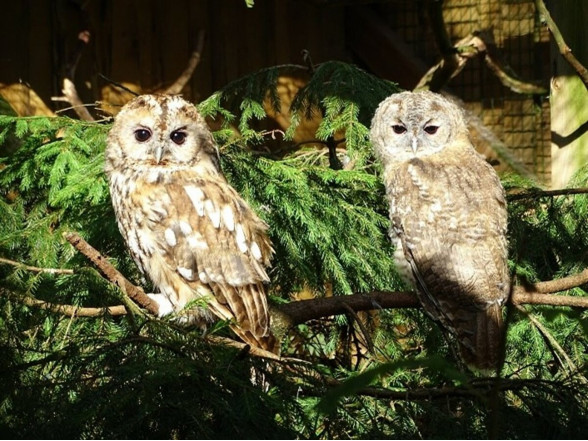On March 10, the TV3 channel morning show "900 sekundes” (900 seconds) informed about the study on owl luminescence carried out by researchers at the Riga Zoo and the ISSP UL.
Many people don’t even know that owls can luminesce. Humans can see this fluorescence, which is a particular type of luminescence, only in ultraviolet light, but scientists are convinced that animals can see fluorescence without additional devices. For the first time in the history of science, researchers at the Riga National Zoo and the ISSP UL have described precisely what wavelengths of light fluoresce owl feathers.
The Barn Owl was brought to Riga Zoo a year ago after an injury. She cannot return to the wild because she has lost an eye. Now, this owl is taking part in a scientific study.
To demonstrate the phenomenon, the Head of Science and Education of the Riga Zoo, Rebeka Šķerstiņa, uses the ultraviolet flashlight with a yellow filter and turns off the light. She explains that the yellow filter helps to create contrast because the blue ultraviolet light makes the pink luminescence look purple, monochrome, and harder to see.
The owl initially looks blue under ultraviolet light. But when the yellow filter is added to the camera, we can see the owl’s reddish-pink fluorescence.
The ISSP UL’s Laboratory of Spectroscopy recorded the luminescence of different owl species with precision instruments. Scientists have known about owl fluorescence for almost a hundred years. But only now have researchers made measurements of a wide spectrum of light and summarized the results in a scientific paper published in a Finnish scientific journal.
"This was a surprise for me. In the spectroscopy lab, we usually work with glass, ceramics, and monocrystals to measure luminescence. Here we had something completely different, biological samples. It was very interesting for my colleagues and me; we had not thought that owls show measurable luminescence," Meldra Ķemere, a researcher in the ISSP UL’s Laboratory of Spectroscopy, explains.
Riga Zoo researchers already have a hypothesis on how owls can use luminescence for hunting: the owl supposedly blinds its prey with red feathers on its wings and belly.
"Owls can see fluorescence, and the rodents they hunt, can also see owl fluorescence, so we hypothesize that in some owl species, fluorescence helps both hunting and communication," says Alessandro di Marzio, senior researcher at the Riga National Zoo.
Another new development was that the research team confirmed the luminescence of white owls. Previously, it was thought these owls lacked a necessary molecule in their feathers to produce luminescence. But now it is proven that white owls hide other colors under their white wings.



